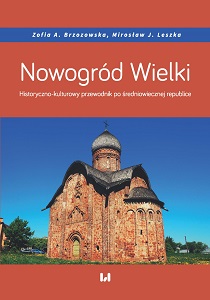Nowogród Wielki. Historyczno-kulturowy przewodnik po średniowiecznej republice
Veliky Novgorod. A Historical and Cultural Guidebook to the Medieval Republic
Author(s): Zofia A. Brzozowska, Mirosław J. Leszka
Subject(s): History, Cultural history, Geography, Regional studies, Human Geography
Published by: Wydawnictwo Uniwersytetu Łódzkiego
Keywords: Novgorod First Chronicle;Novgorod bishops and archbishops;Novgorod princes;Novgorod Eastern Orthodox churches;Yaroslav’s Court;St. Sophia Cathedral;Novgorod Kremlin;Rurikovo Gorodische;Veliky Novgorod
Summary/Abstract: This is the first guide to Veliky Novgorod written in Polish. It offers a tour of about forty-five historical sites in the city and the surrounding area, arranged in a geographical order. These include the Novgorod Kremlin, St. Sophia Cathedral, the seat of the archbishops of Novgorod, Yaroslav’s Court, the Marketplace, houses of the Hansa League merchants, Rurikovo Gorodische. The reader will find here not only a coherent history of the city and of the political entity associated with it – the medieval merchant republic, but also a systematic presentation of the most significant topics related to Novgorod’s cultural and religious character, the independent development of which was shaped by the influence of the Byzantine civilization.Veliky Novgorod, one of many cities in the European part of contemporary Russia, located – as the iconic Polish singer and poet Jacek Kaczmarski put it – “among fields and marshlands,” is a real enigma. It has fascinated numerous artists and researchers for centuries, so much so that in the popular image of Veliky Novgorod, historical truth has become inseparably intertwined with myth. Even back in the Middle Ages, Veliky Novgorod ignited the imagination with its richness of a thriving trading hub which had been in contact with the Hanseatic League since the late twelfth century, and thus – for many centuries before the founding of St. Petersburg – a kind of Rus’ people’s window on Europe. The unique culture of the city on the Volkhov River, flourishing most fully from the 13th to the 15th century, and then brutally suppressed by Muscovite rulers, belies the stereotypical assumption which would perceive the Eastern Slavs as incapable of living in a democratic system.
From the Preface
Series: Uniwersytet Łódzki
- E-ISBN-13: 978-83-8142-697-8
- Print-ISBN-13: 978-83-8142-696-1
- Page Count: 268
- Publication Year: 2019
- Language: Polish
- eBook-PDF
- Table of Content
- Introduction

